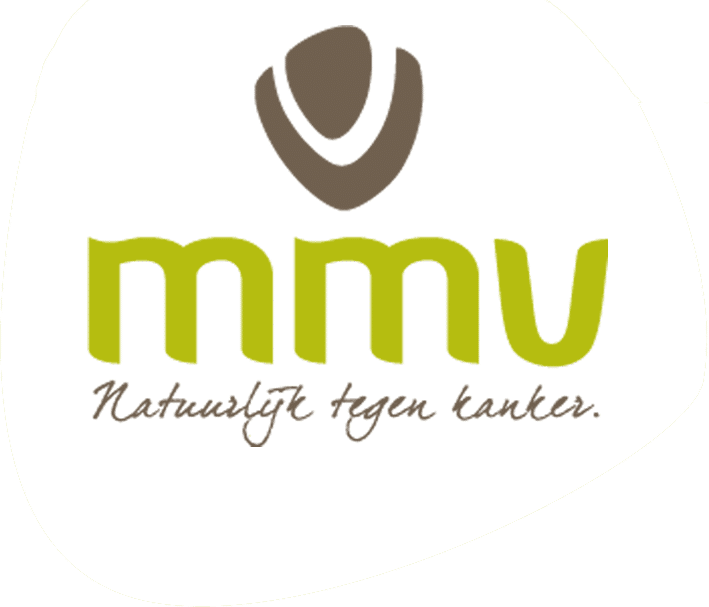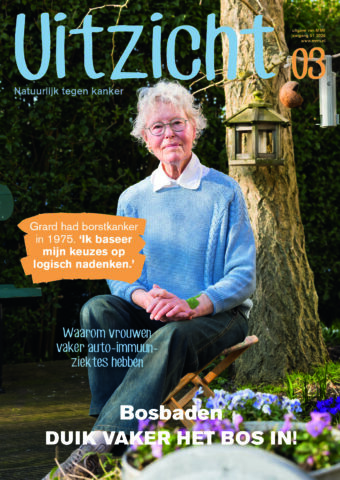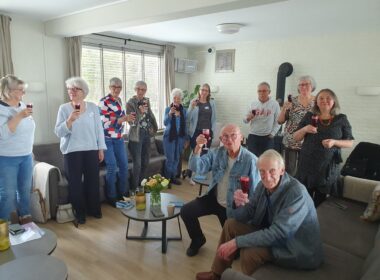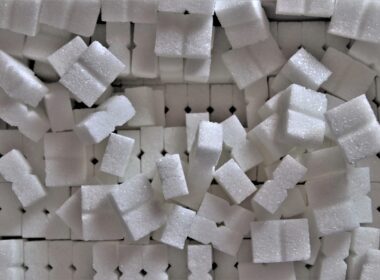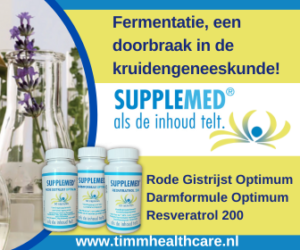Iedereen kent wel iemand met ‘lactose-intolerantie’ en een baby met (het vermoeden van) koemelkallergie. Is dit terecht of krijgt lactose ten onrechte de schuld van allerhande buikklachten?

Lactose, ook wel ‘melksuiker’, komt van nature alleen voor in zoogdierenmelk. Het vormt ongeveer 40 procent van de moedermelkenergie (1-6).Ten opzichte van vet en eiwit is lactose het meest stabiele moedermelk macronutriënt (7). Vanaf vijftien dagen na de geboorte is het gehalte 6-7 gram per 100 mL (8-12). Van alle zoogdieren hebben mensen en apen de hoogste moedermelk lactosegehaltes. Koemelk bevat gemiddeld 4,8 g lactose per 100 mL (2a,5). Het zogende kind kan 60-70 gram lactose per dag prima verdragen. Dat is de hoeveelheid lactose in 1 liter moedermelk: de maximale dagproductie van een vrouw (13,13a).
Lactose heeft een speciale functie in het zogend kind voor wie de moedermelk is bedoeld. Hoe kan het dan dat we massaal denken dat lactose de oorzaak van ellende is?
In onze dunne darm wordt lactose door het enzym lactase gesplitst in glucose en galactose (1-6). Slechts een klein deel van de lactose belandt in de dikke darm. Daar draagt het bij aan de groei van Bifido- en melkzuurbacteriën die uiterst gunstig zijn voor de gezondheid van de zuigeling. Naast energiebron is lactose dus een belangrijk prebioticum (14-17).
Lactose die in de dikke darm terecht komt, wordt vaak gelinkt aan het ontstaan van krampjes (koliek) en ‘huilbaby’s (13,18-33). Vanwege een vermeende ‘lactose-intolerantie’ en zelfs ‘koemelkallergie’ kan zo’n borst-gevoede baby onterecht op een lactose-vrije of hypoallergene kunstvoeding worden gezet (2,13,22). Soms is er inderdaad een tijdelijk lactasetekort, zoals bij een voorbijgaande maagdarminfectie (5,13,17,34.34a,43a). Bijvoorbeeld vanwege het besmettelijke Rotavirus dat veel jonge kinderen treft (34a,35-37). In het uiterst zeldzame geval van ‘congenitale lactasedeficiëntie’ zal er nooit lactaseactiviteit zijn. Om ernstige buikklachten te voorkomen, is het dan écht nodig om lactose levenslang te vermijden (5,13,17,34).
Naast energiebron is lactose een belangrijk prebioticum voor zuigelingen
Krampjes zijn onschuldig, vergen geen geneesmiddelen (38) en dragen waarschijnlijk bij aan de ontwikkeling van het microbioom, het immuunsysteem, de darm-hersenas en de rijping van het maag-darmkanaal (28,30,39,40). Wie heeft gezegd dat de evolutie elegant is? Krampjes komen voor bij 10 tot 20 (33,39) procent van zowel borst als fles-gevoede baby’s (30), zijn bij de meeste rond tien tot twaalf weken verdwenen (25) en houden binnen vijf maanden vanzelf op (41). Geruststelling van de vaak zeer vermoeide ouders is het devies (30,38,42).
En hoe zit het met volwassenen? Evenals bij zuigelingen lijkt ook bij hen een epidemie van lactose-intolerantie aan de gang. In het grootste deel van de wereldbevolking daalt vanaf 3-5 jarige leeftijd de lactase-activiteit geleidelijk tot uiteindelijk 5-10 procent. Bij dertig procent blijft de lactaseactiviteit op sterkte: ze zijn ‘lactasepersistent’. Het gaat om 83-95 procent van de blanke bevolking en populaties in Eurazië en Afrika die vaak sinds de oudheid veeteelt hebben bedreven (1-3,14, 44-68a).
Lactose-intolerantie kan uitsluitend worden vastgesteld aan de hand van symptomen, lichamelijk onderzoek en een positieve uitslag van een lactose-tolerantietest (34,43,43a). Als je ‘lactase non-persistent’ bent, wil dat niet zeggen dat je ‘lactose-intolerant’ bent. Gemiddeld ‘tolereren’ lactase non-persistente volwassenen 1 glas koemelk (250 mL) in een keer of 1,5 glazen genomen over de dag.
In plaats van koemelk kan ook yoghurt worden genomen. De lactosegehaltes van koemelk en yoghurt zijn nagenoeg gelijk (2). Yoghurt is als ‘synbioticum’ gunstiger voor de darmen; het bevat levende melkzuurbacteriën samen met hun voeding (2a,5,12,17,51,61,69-71).
Zowel lactasepersistente als non-persistente personen kunnen (chronische) darmziektes krijgen (5,13,17,34,34a,43a). Lactose wordt dan al snel als schuldige aangewezen. Berucht is het prikkelbare-darm-syndroom dat bij 9 tot 12 procent van de bevolking voorkomt (17,34,72,73). Zoals cholesterol, verzadigd vet en zout worden aangewezen als boosdoeners voor hart en vaatziekten, heeft lactose bij darmziekten onterecht een slechte naam.
Foto door Helena Lopes
1. Troelsen JT. Adult-type hypolactasia and regulation of lactase expression. Biochim Biophys Acta. 2005 May 25;1723(1-3):19-32. doi: 10.1016/j.bbagen.2005.02.003. Epub 2005 Feb 25. PMID: 15777735.
https://pubmed.ncbi.nlm.nih.gov/15777735/
2. Lomer MC, Parkes GC, Sanderson JD. Review article: lactose intolerance in clinical practice–myths and realities. Aliment Pharmacol Ther. 2008 Jan 15;27(2):93-103. doi: 10.1111/j.1365-2036.2007.03557.x. Epub 2007 Oct 23. PMID: 17956597.
https://pubmed.ncbi.nlm.nih.gov/17956597/
2a. Schaafsma G. Lactose and lactose derivatives as bioactive ingredients in human nutrition. International Dairy Journal 18 (2008) 458–465. https://doi.org/10.1016/j.idairyj.2007.11.013
https://www.sciencedirect.com/science/article/abs/pii/S0958694607002300
3. Campbell AK, Waud JP, Matthews SB. The molecular basis of lactose intolerance. Sci Prog. 2009;92(Pt 3-4):241-87. doi: 10.3184/003685009X12547510332240. PMID: 19960866.
https://pubmed.ncbi.nlm.nih.gov/19960866/
4. Amiri M, Diekmann L, von Köckritz-Blickwede M, Naim HY. The Diverse Forms of Lactose Intolerance and the Putative Linkage to Several Cancers. Nutrients. 2015 Aug 28;7(9):7209-30. doi: 10.3390/nu7095332. PMID: 26343715; PMCID: PMC4586527.
https://pubmed.ncbi.nlm.nih.gov/26343715/
5. Silanikove N, Leitner G, Merin U. The Interrelationships between Lactose Intolerance and the Modern Dairy Industry: Global Perspectives in Evolutional and Historical Backgrounds. Nutrients. 2015 Aug 31;7(9):7312-31. doi: 10.3390/nu7095340. PMID: 26404364; PMCID: PMC4586535.
https://pubmed.ncbi.nlm.nih.gov/26404364/
6. Romero-Velarde E, Delgado-Franco D, García-Gutiérrez M, Gurrola-Díaz C, Larrosa-Haro A, Montijo-Barrios E, Muskiet FAJ, Vargas-Guerrero B, Geurts J. The Importance of Lactose in the Human Diet: Outcomes of a Mexican Consensus Meeting. Nutrients. 2019 Nov 12;11(11):2737. doi: 10.3390/nu11112737. PMID: 31718111; PMCID: PMC6893676.
https://pubmed.ncbi.nlm.nih.gov/31718111/
7. Ballard O, Morrow AL. Human milk composition: nutrients and bioactive factors. Pediatr Clin North Am. 2013 Feb;60(1):49-74. doi: 10.1016/j.pcl.2012.10.002. PMID: 23178060; PMCID: PMC3586783.
https://pubmed.ncbi.nlm.nih.gov/23178060/
8. Gidrewicz DA, Fenton TR. A systematic review and meta-analysis of the nutrient content of preterm and term breast milk. BMC Pediatr. 2014 Aug 30;14:216. doi: 10.1186/1471-2431-14-216. PMID: 25174435; PMCID: PMC4236651.
https://pubmed.ncbi.nlm.nih.gov/25174435/
9. Martin CR, Ling PR, Blackburn GL. Review of Infant Feeding: Key Features of Breast Milk and Infant Formula. Nutrients. 2016 May 11;8(5):279. doi: 10.3390/nu8050279. PMID: 27187450; PMCID: PMC4882692.
https://pubmed.ncbi.nlm.nih.gov/27187450/
10. Fischer Fumeaux CJ, Garcia-Rodenas CL, De Castro CA, Courtet-Compondu MC, Thakkar SK, Beauport L, Tolsa JF, Affolter M. Longitudinal Analysis of Macronutrient Composition in Preterm and Term Human Milk: A Prospective Cohort Study. Nutrients. 2019 Jul 4;11(7):1525. doi: 10.3390/nu11071525. PMID: 31277502; PMCID: PMC6683284.
https://pubmed.ncbi.nlm.nih.gov/31277502/
11. Kim SY, Yi DY. Components of human breast milk: from macronutrient to microbiome and microRNA. Clin Exp Pediatr. 2020 Aug;63(8):301-309. doi: 10.3345/cep.2020.00059. Epub 2020 Mar 23. PMID: 32252145; PMCID: PMC7402982.
https://pubmed.ncbi.nlm.nih.gov/32252145/
12. Leghi GE, Middleton PF, Netting MJ, Wlodek ME, Geddes DT, Muhlhausler BS. A Systematic Review of Collection and Analysis of Human Milk for Macronutrient Composition. J Nutr. 2020 Jun 1;150(6):1652-1670. doi: 10.1093/jn/nxaa059. PMID: 32240307.
https://pubmed.ncbi.nlm.nih.gov/32240307/
13. Heine RG, AlRefaee F, Bachina P, De Leon JC, Geng L, Gong S, Madrazo JA, Ngamphaiboon J, Ong C, Rogacion JM. Lactose intolerance and gastrointestinal cow’s milk allergy in infants and children – common misconceptions revisited. World Allergy Organ J. 2017 Dec 12;10(1):41. doi: 10.1186/s40413-017-0173-0. PMID: 29270244; PMCID: PMC5726035.
https://pubmed.ncbi.nlm.nih.gov/29270244/
13a. Neville MC, Keller R, Seacat J, Lutes V, Neifert M, Casey C, Allen J, Archer P. Studies in human lactation: milk volumes in lactating women during the onset of lactation and full lactation. Am J Clin Nutr. 1988 Dec;48(6):1375-86. doi: 10.1093/ajcn/48.6.1375. PMID: 3202087.
https://pubmed.ncbi.nlm.nih.gov/3202087/
14. Szilagyi A. Redefining lactose as a conditional prebiotic. Can J Gastroenterol. 2004 Mar;18(3):163-7. doi: 10.1155/2004/350732. PMID: 15054489.
https://pubmed.ncbi.nlm.nih.gov/15054489/
15. Goodrich JK, Davenport ER, Clark AG, Ley RE. The Relationship Between the Human Genome and Microbiome Comes into View. Annu Rev Genet. 2017 Nov 27;51:413-433. doi: 10.1146/annurev-genet-110711-155532. Epub 2017 Sep 20. PMID: 28934590; PMCID: PMC5744868.
https://pubmed.ncbi.nlm.nih.gov/28934590/
16. Ségurel L, Bon C. On the Evolution of Lactase Persistence in Humans. Annu Rev Genomics Hum Genet. 2017 Aug 31;18:297-319. doi: 10.1146/annurev-genom-091416-035340. Epub 2017 Apr 19. PMID: 28426286.
https://pubmed.ncbi.nlm.nih.gov/28426286/
17. Corgneau M, Scher J, Ritie-Pertusa L, Le DTL, Petit J, Nikolova Y, Banon S, Gaiani C. Recent advances on lactose intolerance: Tolerance thresholds and currently available answers. Crit Rev Food Sci Nutr. 2017 Oct 13;57(15):3344-3356. doi: 10.1080/10408398.2015.1123671. PMID: 26713460.
https://pubmed.ncbi.nlm.nih.gov/26713460/
18. Lucas A, St James-Roberts I. Crying, fussing and colic behaviour in breast- and bottle-fed infants. Early Hum Dev. 1998 Nov;53(1):9-18. doi: 10.1016/s0378-3782(98)00032-2. PMID: 10193923.
https://pubmed.ncbi.nlm.nih.gov/10193923/
19. Lucassen PL, Assendelft WJ, van Eijk JT, Gubbels JW, Douwes AC, van Geldrop WJ. Systematic review of the occurrence of infantile colic in the community. Arch Dis Child. 2001 May;84(5):398-403. doi: 10.1136/adc.84.5.398. PMID: 11316682; PMCID: PMC1718751.
https://pubmed.ncbi.nlm.nih.gov/11316682/
20. Roberts DM, Ostapchuk M, O’Brien JG. Infantile colic. Am Fam Physician. 2004 Aug 15;70(4):735-40. PMID: 15338787.
https://pubmed.ncbi.nlm.nih.gov/15338787/
21. Bailey SD, D’Auria JP, Haushalter JP. Information on infantile colic on the World Wide Web. J Pediatr Health Care. 2013 Nov-Dec;27(6):443-50. doi: 10.1016/j.pedhc.2012.04.009. Epub 2012 Jun 2. PMID: 22664097.
https://pubmed.ncbi.nlm.nih.gov/22664097/
22. Nocerino R, Pezzella V, Cosenza L, Amoroso A, Di Scala C, Amato F, Iacono G, Canani RB. The controversial role of food allergy in infantile colic: evidence and clinical management. Nutrients. 2015 Mar 19;7(3):2015-25. doi: 10.3390/nu7032015. PMID: 25808260; PMCID: PMC4377897.
https://pubmed.ncbi.nlm.nih.gov/25808260/
23. Benninga MA, Faure C, Hyman PE, St James Roberts I, Schechter NL, Nurko S. Childhood Functional Gastrointestinal Disorders: Neonate/Toddler. Gastroenterology. 2016 Feb 15:S0016-5085(16)00182-7. doi: 10.1053/j.gastro.2016.02.016. Epub ahead of print. PMID: 27144631.
https://pubmed.ncbi.nlm.nih.gov/27144631/
24. Pace CA. Infantile Colic: What to Know for the Primary Care Setting. Clin Pediatr (Phila). 2017 Jun;56(7):616-618. doi: 10.1177/0009922816664062. Epub 2016 Aug 15. PMID: 27530504.
https://pubmed.ncbi.nlm.nih.gov/27530504/
25. Wolke D, Bilgin A, Samara M. Systematic Review and Meta-Analysis: Fussing and Crying Durations and Prevalence of Colic in Infants. J Pediatr. 2017 Jun;185:55-61.e4. doi: 10.1016/j.jpeds.2017.02.020. Epub 2017 Apr 3. PMID: 28385295.
https://pubmed.ncbi.nlm.nih.gov/28385295/
26. García Marqués S, Chillón Martínez R, González Zapata S, Rebollo Salas M, Jiménez Rejano JJ. Tools assessment and diagnosis to infant colic: a systematic review. Child Care Health Dev. 2017 Jul;43(4):481-488. doi: 10.1111/cch.12454. Epub 2017 Mar 5. PMID: 28261843.
https://pubmed.ncbi.nlm.nih.gov/28261843/
27. Camilleri M, Park SY, Scarpato E, Staiano A. Exploring hypotheses and rationale for causes of infantile colic. Neurogastroenterol Motil. 2017 Feb;29(2):10.1111/nmo.12943. doi: 10.1111/nmo.12943. Epub 2016 Sep 20. PMID: 27647578; PMCID: PMC5276723.
https://pubmed.ncbi.nlm.nih.gov/27647578/
28. Pärtty A, Kalliomäki M. Infant colic is still a mysterious disorder of the microbiota-gut-brain axis. Acta Paediatr. 2017 Apr;106(4):528-529. doi: 10.1111/apa.13754. PMID: 28318126.
https://pubmed.ncbi.nlm.nih.gov/28318126/
29. Sung V, Cabana MD. Probiotics for Colic-Is the Gut Responsible for Infant Crying After All? J Pediatr. 2017 Dec;191:6-8. doi: 10.1016/j.jpeds.2017.09.010. PMID: 29173324.
https://pubmed.ncbi.nlm.nih.gov/29173324/
30. Zeevenhooven J, Browne PD, L’Hoir MP, de Weerth C, Benninga MA. Infant colic: mechanisms and management. Nat Rev Gastroenterol Hepatol. 2018 Aug;15(8):479-496. doi: 10.1038/s41575-018-0008-7. PMID: 29760502.
https://pubmed.ncbi.nlm.nih.gov/29760502/
31. Rhoads JM, Collins J, Fatheree NY, Hashmi SS, Taylor CM, Luo M, Hoang TK, Gleason WA, Van Arsdall MR, Navarro F, Liu Y. Infant Colic Represents Gut Inflammation and Dysbiosis. J Pediatr. 2018 Dec;203:55-61.e3. doi: 10.1016/j.jpeds.2018.07.042. Epub 2018 Aug 31. PMID: 30177353; PMCID: PMC6669027.
https://pubmed.ncbi.nlm.nih.gov/30177353/
32. Sung V. Infantile colic. Aust Prescr. 2018 Aug;41(4):105-110. doi: 10.18773/austprescr.2018.033. Epub 2018 Aug 1. PMID: 30116077; PMCID: PMC6091773.
https://pubmed.ncbi.nlm.nih.gov/30116077/
33. Muhardi L, Aw MM, Hasosah M, Ng RT, Chong SY, Hegar B, Toro-Monjaraz E, Darma A, Cetinkaya M, Chow CM, Kudla U, Vandenplas Y. A Narrative Review on the Update in the Prevalence of Infantile Colic, Regurgitation, and Constipation in Young Children: Implications of the ROME IV Criteria. Front Pediatr. 2022 Jan 5;9:778747. doi: 10.3389/fped.2021.778747. PMID: 35071132; PMCID: PMC8767117.
https://pubmed.ncbi.nlm.nih.gov/35071132/
34. Malik TF, Panuganti KK. Lactose Intolerance. 2021 Jul 29. In: StatPearls [Internet]. Treasure Island (FL): StatPearls Publishing; 2022 Jan–. PMID: 30335318.
https://pubmed.ncbi.nlm.nih.gov/30335318/
34a. Arora S, Singla N. Lactose Intolerance in Infants, Children, and Adolescents
https://www.pediatriconcall.com/pediatric-journal/view/fulltext-articles/449/J/0/0/357/0
35. Rotavirus. Rijksinstituut voor Volksgezondheid en Milieu Ministerie van Volksgezondheid, Welzijn en Sport; Wijzigingsdatum 05-07-2021 | 12:41. Accessed 13 02 2022
36. Lactose Intolerance. American College of Gastroenterology. Accessed 13 02 2022
37. Hu Y, Gui L, Chang J, Liu J, Xu S, Deng C, Yu F, Ma Z, Wang G, Zhang C. The incidence of infants with rotavirus enteritis combined with lactose intolerance. Pak J Pharm Sci. 2016 Jan;29(1 Suppl):321-3. PMID: 27005498.
https://pubmed.ncbi.nlm.nih.gov/27005498/
38. Vandenplas Y, Benninga M, Broekaert I, Falconer J, Gottrand F, Guarino A, Lifschitz C, Lionetti P, Orel R, Papadopoulou A, Ribes-Koninckx C, Ruemmele FM, Salvatore S, Shamir R, Schäppi M, Staiano A, Szajewska H, Thapar N, Wilschanski M. Functional gastro-intestinal disorder algorithms focus on early recognition, parental reassurance and nutritional strategies. Acta Paediatr. 2016 Mar;105(3):244-52. doi: 10.1111/apa.13270. Epub 2015 Dec 21. Erratum in: Acta Paediatr. 2016 Aug;105(8):984. PMID: 26584953.
https://pubmed.ncbi.nlm.nih.gov/26584953/
39. Shamir R, St James-Roberts I, Di Lorenzo C, Burns AJ, Thapar N, Indrio F, Riezzo G, Raimondi F, Di Mauro A, Francavilla R, Leuchter RH, Darque A, Hüppi PS, Heine RG, Bellaïche M, Levy M, Jung C, Alvarez M, Hovish K. Infant crying, colic, and gastrointestinal discomfort in early childhood: a review of the evidence and most plausible mechanisms. J Pediatr Gastroenterol Nutr. 2013 Dec;57 Suppl 1:S1-45. doi: 10.1097/MPG.0b013e3182a154ff. PMID: 24356023.
https://pubmed.ncbi.nlm.nih.gov/24356023/
40. Ouald Chaib A, Levy EI, Ouald Chaib M, Vandenplas Y. The influence of the gastrointestinal microbiome on infant colic. Expert Rev Gastroenterol Hepatol. 2020 Oct;14(10):919-932. doi: 10.1080/17474124.2020.1791702. Epub 2020 Jul 21. PMID: 32633578.
https://pubmed.ncbi.nlm.nih.gov/32633578/
41. Vandenplas Y, Abkari A, Bellaiche M, Benninga M, Chouraqui JP, Çokura F, Harb T, Hegar B, Lifschitz C, Ludwig T, Miqdady M, de Morais MB, Osatakul S, Salvatore S, Shamir R, Staiano A, Szajewska H, Thapar N. Prevalence and Health Outcomes of Functional Gastrointestinal Symptoms in Infants From Birth to 12 Months of Age. J Pediatr Gastroenterol Nutr. 2015 Nov;61(5):531-7. doi: 10.1097/MPG.0000000000000949. Erratum in: J Pediatr Gastroenterol Nutr. 2016 Mar;62(3):516. PMID: 26308317; PMCID: PMC4631121.
https://pubmed.ncbi.nlm.nih.gov/26308317/
42. Pace CA. Infantile Colic: What to Know for the Primary Care Setting. Clin Pediatr (Phila). 2017 Jun;56(7):616-618. doi: 10.1177/0009922816664062. Epub 2016 Aug 15. PMID: 27530504.
https://pubmed.ncbi.nlm.nih.gov/27530504/
43. Suchy FJ, Brannon PM, Carpenter TO, Fernandez JR, Gilsanz V, Gould JB, Hall K, Hui SL, Lupton J, Mennella J, Miller NJ, Osganian SK, Sellmeyer DE, Wolf MA. NIH consensus development conference statement: Lactose intolerance and health. NIH Consens State Sci Statements. 2010 Feb 24;27(2):1-27. PMID: 20186234.
https://pubmed.ncbi.nlm.nih.gov/20186234/
43a. Fassio F, Facioni MS, Guagnini F. Lactose Maldigestion, Malabsorption, and Intolerance: A Comprehensive Review with a Focus on Current Management and Future Perspectives. Nutrients. 2018 Nov 1;10(11):1599. doi: 10.3390/nu10111599. PMID: 30388735; PMCID: PMC6265758.
https://pubmed.ncbi.nlm.nih.gov/30388735/
44. Montgomery RK, Büller HA, Rings EH, Grand RJ. Lactose intolerance and the genetic regulation of intestinal lactase-phlorizin hydrolase. FASEB J. 1991 Oct;5(13):2824-32. doi: 10.1096/fasebj.5.13.1916106. PMID: 1916106.
https://pubmed.ncbi.nlm.nih.gov/1916106/
45. Grand RJ, Montgomery RK, Chitkara DK, Hirschhorn JN. Changing genes; losing lactase. Gut. 2003 May;52(5):617-9. doi: 10.1136/gut.52.5.617. PMID: 12692040; PMCID: PMC1773627.
https://pubmed.ncbi.nlm.nih.gov/12692040/
45a. Swallow DM. Genetics of lactase persistence and lactose intolerance. Annu Rev Genet. 2003;37:197-219. doi: 10.1146/annurev.genet.37.110801.143820. PMID: 14616060.
https://pubmed.ncbi.nlm.nih.gov/14616060/
46. Ingram CJ, Elamin MF, Mulcare CA, Weale ME, Tarekegn A, Raga TO, Bekele E, Elamin FM, Thomas MG, Bradman N, Swallow DM. A novel polymorphism associated with lactose tolerance in Africa: multiple causes for lactase persistence? Hum Genet. 2007 Feb;120(6):779-88. doi: 10.1007/s00439-006-0291-1. Epub 2006 Nov 21. PMID: 17120047.
https://pubmed.ncbi.nlm.nih.gov/17120047/
47. Ingram CJ, Mulcare CA, Itan Y, Thomas MG, Swallow DM. Lactose digestion and the evolutionary genetics of lactase persistence. Hum Genet. 2009 Jan;124(6):579-91. doi: 10.1007/s00439-008-0593-6. Epub 2008 Nov 26. PMID: 19034520.
https://pubmed.ncbi.nlm.nih.gov/19034520/
48. Schultheis PJ, Bowling BV. Analysis of a SNP linked to lactase persistence: An exercise for teaching molecular biology techniques to undergraduates. Biochem Mol Biol Educ. 2011 Mar-Apr;39(2):133-40. doi: 10.1002/bmb.20456. PMID: 21445905.
https://pubmed.ncbi.nlm.nih.gov/21445905/
49. Jones BL, Swallow DM. The impact of cis-acting polymorphisms on the human phenotype. Hugo J. 2011 Dec;5(1-4):13-23. doi: 10.1007/s11568-011-9155-4. Epub 2011 Jul 20. PMID: 23205161; PMCID: PMC3238023.
https://pubmed.ncbi.nlm.nih.gov/23205161/
50. Sibley E, Ahn JK. Theodore E. Woodward Award: lactase persistence SNPs in African populations regulate promoter activity in intestinal cell culture. Trans Am Clin Climatol Assoc. 2011;122:155-65. PMID: 21686221; PMCID: PMC3116366.
https://pubmed.ncbi.nlm.nih.gov/21686221/
51. Brüssow H. Nutrition, population growth and disease: a short history of lactose. Environ Microbiol. 2013 Aug;15(8):2154-61. doi: 10.1111/1462-2920.12117. Epub 2013 Apr 9. PMID: 23574334.
https://pubmed.ncbi.nlm.nih.gov/23574334/
52. Curry A. Archaeology: The milk revolution. Nature. 2013 Aug 1;500(7460):20-2. doi: 10.1038/500020a. PMID: 23903732.
https://pubmed.ncbi.nlm.nih.gov/23903732/
53. Gerbault P. The onset of lactase persistence in Europe. Hum Hered. 2013;76(3-4):154-61. doi: 10.1159/000360136. Epub 2014 May 21. PMID: 24861860.
https://pubmed.ncbi.nlm.nih.gov/24861860/
54. Ranciaro A, Campbell MC, Hirbo JB, Ko WY, Froment A, Anagnostou P, Kotze MJ, Ibrahim M, Nyambo T, Omar SA, Tishkoff SA. Genetic origins of lactase persistence and the spread of pastoralism in Africa. Am J Hum Genet. 2014 Apr 3;94(4):496-510. doi: 10.1016/j.ajhg.2014.02.009. Epub 2014 Mar 13. PMID: 24630847; PMCID: PMC3980415.
https://pubmed.ncbi.nlm.nih.gov/24630847/
55. Allentoft ME, Sikora M, Sjögren KG, Rasmussen S, Rasmussen M, Stenderup J, Damgaard PB, Schroeder H, Ahlström T, Vinner L, Malaspinas AS, Margaryan A, Higham T, Chivall D, Lynnerup N, Harvig L, Baron J, Della Casa P, Dąbrowski P, Duffy PR, Ebel AV, Epimakhov A, Frei K, Furmanek M, Gralak T, Gromov A, Gronkiewicz S, Grupe G, Hajdu T, Jarysz R, Khartanovich V, Khokhlov A, Kiss V, Kolář J, Kriiska A, Lasak I, Longhi C, McGlynn G, Merkevicius A, Merkyte I, Metspalu M, Mkrtchyan R, Moiseyev V, Paja L, Pálfi G, Pokutta D, Pospieszny Ł, Price TD, Saag L, Sablin M, Shishlina N, Smrčka V, Soenov VI, Szeverényi V, Tóth G, Trifanova SV, Varul L, Vicze M, Yepiskoposyan L, Zhitenev V, Orlando L, Sicheritz-Pontén T, Brunak S, Nielsen R, Kristiansen K, Willerslev E. Population genomics of Bronze Age Eurasia. Nature. 2015 Jun 11;522(7555):167-72. doi: 10.1038/nature14507. PMID: 26062507.
https://pubmed.ncbi.nlm.nih.gov/26062507/
56. Callaway E. DNA deluge reveals Bronze Age secrets. Nature. 2015 Jun 11;522(7555):140-1. doi: 10.1038/522140a. PMID: 26062491.
https://pubmed.ncbi.nlm.nih.gov/26062491/
57. Szilagyi A. Adaptation to Lactose in Lactase Non Persistent People: Effects on Intolerance and the Relationship between Dairy Food Consumption and Evalution of Diseases. Nutrients. 2015 Aug 13;7(8):6751-79. doi: 10.3390/nu7085309. PMID: 26287234; PMCID: PMC4555148.
https://pubmed.ncbi.nlm.nih.gov/26287234/
58. Labrie V, Buske OJ, Oh E, Jeremian R, Ptak C, Gasiūnas G, Maleckas A, Petereit R, Žvirbliene A, Adamonis K, Kriukienė E, Koncevičius K, Gordevičius J, Nair A, Zhang A, Ebrahimi S, Oh G, Šikšnys V, Kupčinskas L, Brudno M, Petronis A. Lactase nonpersistence is directed by DNA-variation-dependent epigenetic aging. Nat Struct Mol Biol. 2016 Jun;23(6):566-73. doi: 10.1038/nsmb.3227. Epub 2016 May 9. PMID: 27159559; PMCID: PMC4899171.
https://pubmed.ncbi.nlm.nih.gov/27159559/
59. Swallow DM, Troelsen JT. Escape from epigenetic silencing of lactase expression is triggered by a single-nucleotide change. Nat Struct Mol Biol. 2016 Jun 7;23(6):505-7. doi: 10.1038/nsmb.3238. PMID: 27273635.
https://pubmed.ncbi.nlm.nih.gov/27273635/
60. Bayless TM, Brown E, Paige DM. Lactase Non-persistence and Lactose Intolerance. Curr Gastroenterol Rep. 2017 May;19(5):23. doi: 10.1007/s11894-017-0558-9. PMID: 28421381.
https://pubmed.ncbi.nlm.nih.gov/28421381/
61. Ségurel L, Bon C. On the Evolution of Lactase Persistence in Humans. Annu Rev Genomics Hum Genet. 2017 Aug 31;18:297-319. doi: 10.1146/annurev-genom-091416-035340. Epub 2017 Apr 19. PMID: 28426286.
https://pubmed.ncbi.nlm.nih.gov/28426286/
62. Liebert A, López S, Jones BL, Montalva N, Gerbault P, Lau W, Thomas MG, Bradman N, Maniatis N, Swallow DM. World-wide distributions of lactase persistence alleles and the complex effects of recombination and selection. Hum Genet. 2017 Nov;136(11-12):1445-1453. doi: 10.1007/s00439-017-1847-y. Epub 2017 Oct 23. PMID: 29063188; PMCID: PMC5702378.
https://pubmed.ncbi.nlm.nih.gov/29063188/
63. Leseva MN, Grand RJ, Klett H, Boerries M, Busch H, Binder AM, Michels KB. Differences in DNA Methylation and Functional Expression in Lactase Persistent and Non-persistent Individuals. Sci Rep. 2018 Apr 4;8(1):5649. doi: 10.1038/s41598-018-23957-4. PMID: 29618745; PMCID: PMC5884863.
https://pubmed.ncbi.nlm.nih.gov/29618745/
64. Curry A. How can you eat dairy if you lack the gene for digesting it? Fermented milk may be key, ancient Mongolian study suggests. Accessed 14 02 2022
65. Jeong C, Wilkin S, Amgalantugs T, Bouwman AS, Taylor WTT, Hagan RW, Bromage S, Tsolmon S, Trachsel C, Grossmann J, Littleton J, Makarewicz CA, Krigbaum J, Burri M, Scott A, Davaasambuu G, Wright J, Irmer F, Myagmar E, Boivin N, Robbeets M, Rühli FJ, Krause J, Frohlich B, Hendy J, Warinner C. Bronze Age population dynamics and the rise of dairy pastoralism on the eastern Eurasian steppe. Proc Natl Acad Sci U S A. 2018 Nov 27;115(48):E11248-E11255. doi: 10.1073/pnas.1813608115. Epub 2018 Nov 5. PMID: 30397125; PMCID: PMC6275519.
https://pubmed.ncbi.nlm.nih.gov/30397125/
66. Segurel L, Guarino-Vignon P, Marchi N, Lafosse S, Laurent R, Bon C, Fabre A, Hegay T, Heyer E. Why and when was lactase persistence selected for? Insights from Central Asian herders and ancient DNA. PLoS Biol. 2020 Jun 8;18(6):e3000742. doi: 10.1371/journal.pbio.3000742. PMID: 32511234; PMCID: PMC7302802.
https://pubmed.ncbi.nlm.nih.gov/32511234/
67. Anguita-Ruiz A, Aguilera CM, Gil Á. Genetics of Lactose Intolerance: An Updated Review and Online Interactive World Maps of Phenotype and Genotype Frequencies. Nutrients. 2020 Sep 3;12(9):2689. doi: 10.3390/nu12092689. PMID: 32899182; PMCID: PMC7551416.
https://pubmed.ncbi.nlm.nih.gov/32899182/
68. Burger J, Link V, Blöcher J, Schulz A, Sell C, Pochon Z, Diekmann Y, Žegarac A, Hofmanová Z, Winkelbach L, Reyna-Blanco CS, Bieker V, Orschiedt J, Brinker U, Scheu A, Leuenberger C, Bertino TS, Bollongino R, Lidke G, Stefanović S, Jantzen D, Kaiser E, Terberger T, Thomas MG, Veeramah KR, Wegmann D. Low Prevalence of Lactase Persistence in Bronze Age Europe Indicates Ongoing Strong Selection over the Last 3,000 Years. Curr Biol. 2020 Nov 2;30(21):4307-4315.e13. doi: 10.1016/j.cub.2020.08.033. Epub 2020 Sep 3. PMID: 32888485.
https://pubmed.ncbi.nlm.nih.gov/32888485/
68a. Saag L. Human Genetics: Lactase Persistence in a Battlefield. Curr Biol. 2020 Nov 2;30(21):R1311-R1313. doi: 10.1016/j.cub.2020.08.087. PMID: 33142099.
https://pubmed.ncbi.nlm.nih.gov/33142099/
69. EFSA Panel on Dietetic Products, Nutrition and Allergies (NDA); Scientific Opinion on lactose
thresholds in lactose intolerance and galactosaemia. EFSA Journal 2010;8(9):1777. [29 pp.]. doi:10.2903/j.efsa.2010.1777.
https://www.efsa.europa.eu/en/efsajournal/pub/1777
70. Pelletier X, Laure-Boussuge S, Donazzolo Y. Hydrogen excretion upon ingestion of dairy products in lactose-intolerant male subjects: importance of the live flora. Eur J Clin Nutr. 2001 Jun;55(6):509-12. doi: 10.1038/sj.ejcn.1601169. PMID: 11423928.
https://pubmed.ncbi.nlm.nih.gov/11423928/
71. EFSA Panel on Dietetic Products, Nutrition and Allergies (NDA); Scientific Opinion on the
substantiation of health claims related to live yoghurt cultures and improved lactose digestion (ID 1143, 2976) pursuant to Article 13(1) of Regulation (EC) No 1924/2006. EFSA Journal 2010;8(10):1763. [18 pp.]. doi:10.2903/j.efsa.2010.1763.
https://www.efsa.europa.eu/en/efsajournal/pub/1763
72. Szilagyi A. Review article: lactose–a potential prebiotic. Aliment Pharmacol Ther. 2002 Sep;16(9):1591-602. doi: 10.1046/j.1365-2036.2002.01321.x. Erratum in: Aliment Pharmacol Ther. 2003 May 1;17(9):1205. PMID: 12197838.
MMV maakt wekelijks een selectie uit het nieuws over voeding en leefstijl in relatie tot kanker en andere medische condities.
Inschrijven nieuwsbrief
